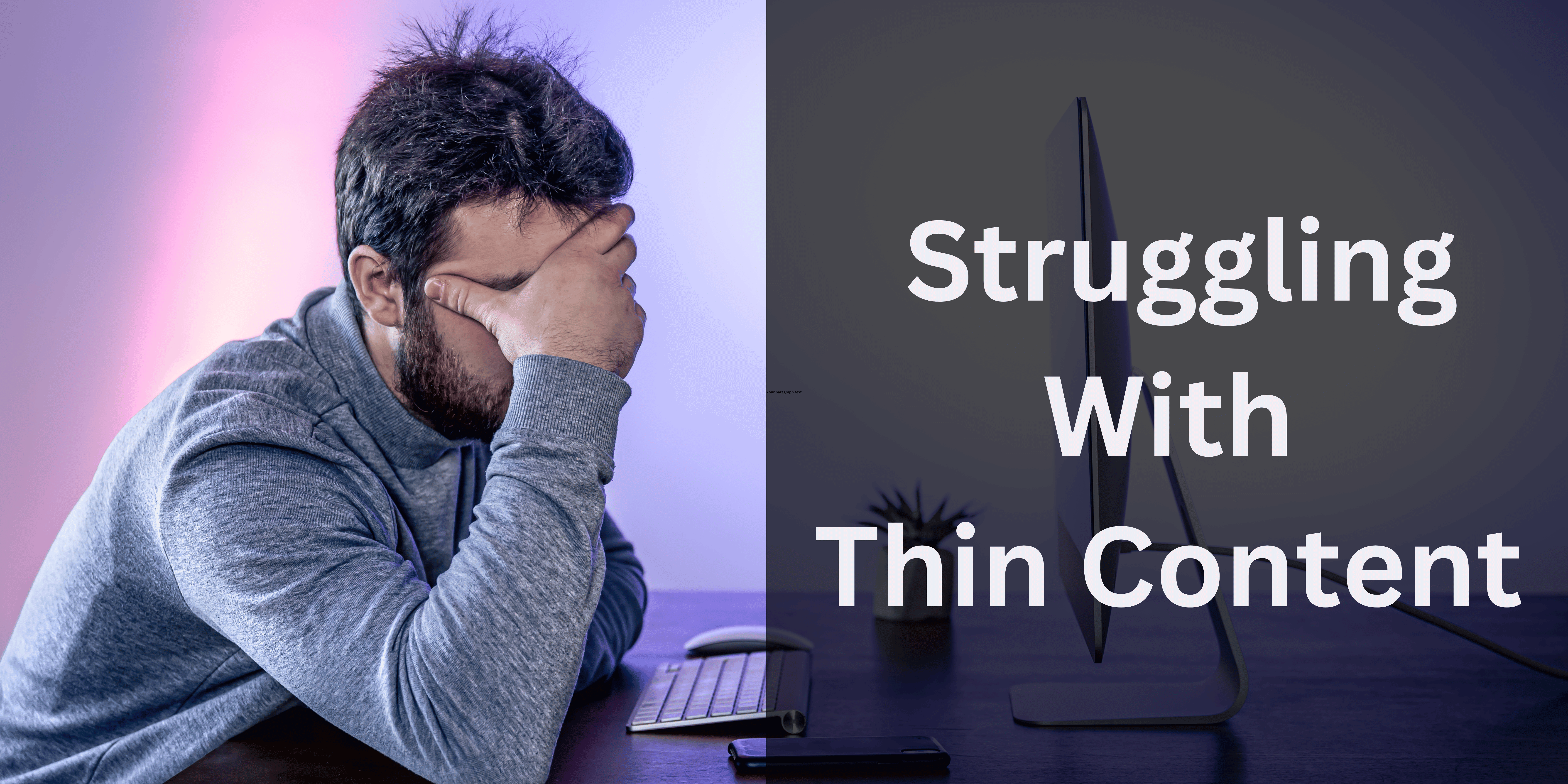Struggling with thin content? How to identify and fix it

by Abhay Raj
What exactly is thin content?
Thin content refers to web pages or articles that lack substantive value or depth, often characterized by shallow or minimalistic information. These pieces typically fail to provide meaningful insights or address the user’s query adequately. Websites with thin content may suffer from various consequences, including poor search engine rankings, reduced user engagement, and diminished credibility.
When websites prioritize quantity over quality and publish thin content, they risk alienating their audience and damaging their online reputation. Users may become frustrated by the lack of useful information and navigate away from the site, resulting in increased bounce rates and decreased conversion rates.
In essence, websites that rely on thin content are likely to suffer from diminished online visibility, reduced user engagement, and ultimately, a decline in overall success.
Example of thin content
An example of thin content could be a webpage with minimal text, shallow explanations, and little relevance to the user’s query.
For instance, imagine a blog post that regurgitates generic information without offering any unique insights or perspectives. Such content not only fails to capture the reader’s interest but also contributes little to their knowledge or understanding of the topic.
Websites that consistently produce thin content risk alienating their audience, experiencing reduced user engagement, and suffering from poor search engine rankings.
Therefore, it’s crucial for website owners to prioritize quality and relevance to avoid the detrimental effects of thin content on their online presence
Why do websites receive penalties for thin content?
Websites receive penalties for thin content primarily because it fails to meet the expectations of users and search engines. Thin content lacks substance, depth, and relevance, often providing little value to visitors. When a website consistently publishes thin content, it diminishes the overall user experience, resulting in:
- Reduced user engagement
- Higher bounce rates
- Lower rankings in search engine results pages (SERPs)
Moreover, thin content can lead to a negative perception of the website’s credibility and authority, further impacting its reputation online. To avoid penalties for thin content, website owners should focus on creating comprehensive, valuable content that addresses the needs and interests of their target audience. This approach improves user satisfaction and search engine visibility.
Impact of Thin Content on SEO Performance
Thin content detrimentally affects SEO performance in several ways:
- Search Engine Penalties: Search engines prioritize high-quality and relevant content. Thin content fails to meet these criteria, leading to potential penalties and lower rankings.
- User Engagement Metrics: Thin content often results in higher bounce rates and lower time spent on page, signaling to search engines that the content may not be effectively satisfying user intent.
- Credibility and Authority: Thin content struggles to attract backlinks from authoritative websites, hindering the website’s overall authority.
As a result, websites with thin content may experience:
- Decreased organic traffic
- Reduced online visibility
- Decline in SEO performance
How to Identify Thin Content
Identifying thin content is crucial for maintaining the quality and performance of a website. Here are key methods to identify thin content:
Key Methods to Identify Thin Content
- Analyze Word Count
- Check for pages with very low word counts. While word count alone doesn’t determine quality, extremely short pages often lack depth.
- Evaluate Content Depth and Value
- Assess whether the content provides comprehensive information and value to the reader. Thin content typically lacks detailed information or actionable insights.
- Check for Duplicate Content
- Use tools to find duplicate content within your site. Duplicate or very similar content can be considered thin if it doesn’t add unique value.
- Review User Engagement Metrics
- Examine metrics like bounce rate, time on page, and pages per session. High bounce rates and low time on page can indicate that users are not finding the content valuable.
- Content Uniqueness and Originality
- Ensure that content is original and not merely copied from other sources. Unique content is more likely to engage users and rank well.
- SEO Audits and Tools
- Utilize SEO tools like Google Search Console, SEMrush, or Ahrefs to identify pages with low performance metrics. These tools can highlight pages with low traffic, few backlinks, or poor rankings.
- Manual Content Review
- Conduct a manual review of your site’s content. Look for pages that do not adequately cover the topic, lack multimedia elements, or have poor formatting.
- Compare with Competitors
- Compare your content with top-ranking competitors. This can help identify gaps in your content and areas where competitors are providing more comprehensive information.
How to Fix Thin Content
Fixing thin content is essential to improve user experience, SEO performance, and overall website quality. Here are practical steps to address and enhance thin content:
- Conduct a Content Audit
- Identify pages with thin content using SEO tools (e.g., Google Search Console, SEMrush, Ahrefs).
- Look for pages with low word count, high bounce rates, low engagement, and minimal backlinks.
- Expand and Enhance Content
- Add more in-depth information, covering various aspects of the topic.
- Include detailed explanations, examples, case studies, and actionable insights.
- Integrate multimedia elements such as images, videos, infographics, and charts to enrich the content.
- Improve Content Quality
- Ensure content is well-researched, accurate, and up-to-date.
- Use authoritative sources and provide references where necessary.
- Enhance readability by using clear, concise language and breaking up text with headings, bullet points, and short paragraphs.
- Optimize for User Intent
- Understand the search intent behind the keywords you’re targeting.
- Tailor the content to meet the specific needs and interests of your audience.
- Answer common questions and provide solutions to problems your audience might face.
- Merge and Consolidate Content
- Combine multiple thin pages on similar topics into a single, comprehensive page.
- Redirect old URLs to the new, consolidated content to preserve any existing link equity.
- Remove or Noindex Low-Value Pages
- Delete content that offers no value and cannot be improved.
- Use “noindex” tags for low-value pages that need to remain on the site but should not appear in search results.
- Add Unique Value
- Differentiate your content by offering unique insights, perspectives, or original research.
- Avoid duplicating content from other sources without adding significant value.
- Enhance On-Page SEO
- Optimize meta titles, descriptions, headers, and images for relevant keywords.
- Ensure proper use of internal linking to improve navigation and distribute page authority.
- Regularly Update Content
- Keep your content fresh and relevant by regularly reviewing and updating it.
- Add new information, update outdated details, and refine content to maintain quality.
- Engage with Your Audience
- Encourage user engagement through comments, feedback, and social sharing.
- Use this interaction to identify content gaps and areas for improvement.
By systematically identifying and addressing thin content, you can transform your website into a valuable resource that engages users and ranks well in search engines.
Conclusion:
Addressing thin content is crucial for enhancing your website’s user experience and SEO performance. By identifying and fixing thin content, you can provide more value to your audience, improve engagement metrics, and boost search engine rankings. Regularly auditing and updating your content ensures it remains relevant and comprehensive. Implement these strategies to transform your website into a trusted, authoritative resource that satisfies user intent and meets search engine standards. Prioritizing high-quality content is a vital step towards long-term online success.
Recommended Posts
Campaign from Fortune Ports Play Campaign out of Luck Ports Free
January 21, 2025
r7 casino
January 20, 2025


